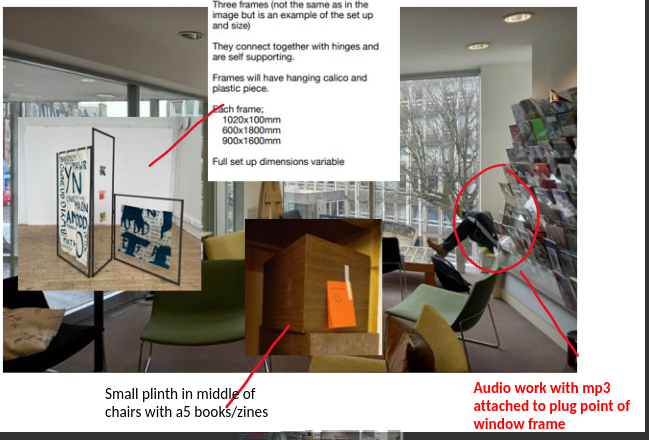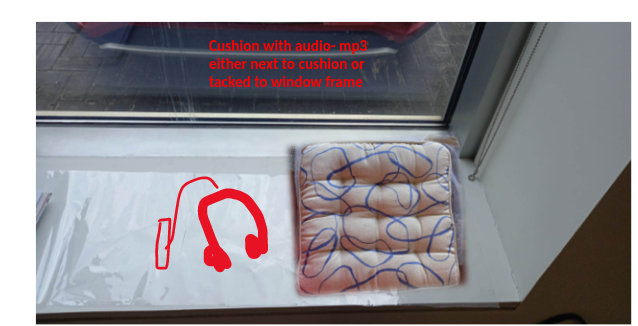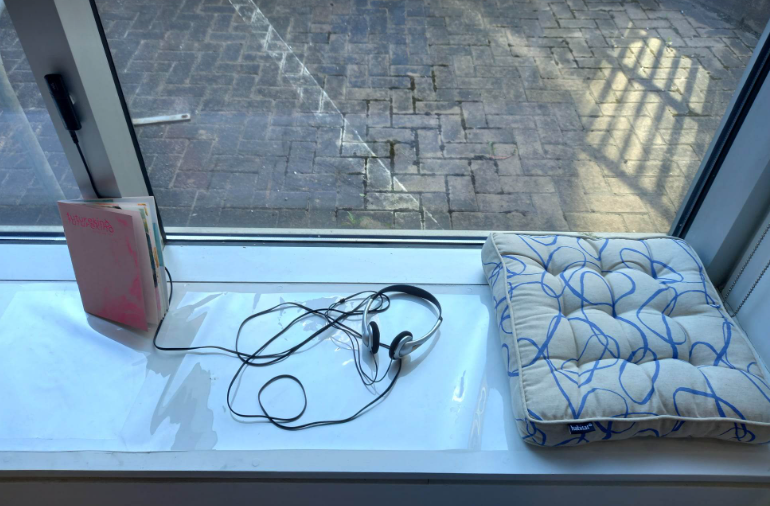As I prepared for the install of Utterances, I made sure I had people to help with this so it could go smoothly without any major disruption. I had sent through to Andrew some finalised visuals for where all artworks would be in the space, making these as specific as possible. I had also let Andrew Baxter know of my plans for the day and the time it should take to install so he had a clear idea of how the exhibition will unfold in the library. (see below images).
I met Alysse, Kinsley and Ffion, along with my housemate Wanda who helped bring artworks to the space, at 9:15 to begin resetting areas of the library to cater for the artworks. As the nature of the exhibition was to ‘sit’ things within the space comfortably without causing any damage or interruption to the library or people using it, this was fairly simple to do. Due to a lot of moving chairs and tables and going to the art store to collect the plinth, this went slightly over schedule but because of the early set-up there was hardly anyone the library at this time.



A slight issue I had was in regard to Alysse’s audio work Polyphonic Utopias; A Futurecast (image below), which was originally to be displayed on the left ledge instead of the one below. This was because of a car that was parked closely to the ledge, creating a distraction to the work (just outside the window is a car park). Me and Alysse decided to move it to the right ledge where it looked much better and had much more light coming in. This was not a major dilemma as there was enough space here and still made sense on the map of what the work is.

Having put the table-like plinth in the space and cushions for audio works, the library felt more intimate and welcoming to us and the new voices that were emerging over the course of a day. Seeing Alysse’s book Futurekind encased by other new publications and the words ‘current journals, gave the work a more expansive quality, distant but a part of a network of the written word. I had decided to place Alysse’s audio work Polyphonic Utopias; a Futurecast, a spoken version of her book, on the other side of the library floor to visualise the themes of time and futuring that appear in both works. The act of walking towards the audio work, past many publications and journals on the way, became more apparent after install and added to the nature of the work to be experienced in two separate areas of the same space. A metre away from Futurekind is Ffions work Beth ydy ti’r experience? echoing Alysse’s use of typography and exploring the Welsh language. It was an early decision in the development of the project to place this here and be framed by the large windows encompassing half of the gallery. This meant people inside the building in the corridor and people on the street outside Evolution House could see the work, highlighting the works questioning of contexts of language learning and visibility. It was great to also hear this remarked on by viewers of the work. Opposite this is Ffions other work Welshness Interviews, in the form of audio, where visitors can sit and listen to her artwork in a wider context. Beth ydy ti’r experience? is still visible when listening to this work so viewers can see the outcome of these interviews and how this research can become artwork. This is similar to Alice’s poems which are encased within poster boards reflecting upon the visual nature of words and their attachment to speech. Situated here, viewers are made aware of the actual ‘display’ of words and the forms these take in Alice’s poems. Being in the space, I saw many people standing back to view these works, taking in all three pieces simultaneously, with a library context of information included. The shapes of words are important here like that of Ffion’s frame piece where we consume language and information visually. Just beyond this is Charlie’s work Postcards from London framed by a grey metal shelf. Including handwritten works were really important and the idea of the postcard seemed especially relevant to the themes of text and image; text here usually to describe the image or provide context in relation to the owners experience of its content. A big question for this work is why make this into bookform and how the book more generally sits into a context of documentation and memory; a major quality of the library space. Charlie’s other works Morning Ablutions and To Rise and Grind, explore the linguistic and visual by means of installation. Here he is pulling out moments within the poems, creating enlarged images he wishes for people to mull over and think over. Kinslee’s Critter Manifesto speaks to the way museums archive and catalogue information and artwork, rethinking language and how we see this in a museum context. Being confined within a ring binder, this looks relevant within the library space but on closer inspection we notice its otherworldly and manic content. This also reflects the library’s nature of old and new; Critter Manifesto is new, made to look old. Being able to walk around the space after install, I could see new qualities in each artwork, the library as exhibition space and what is between text and image.



Leave a Reply